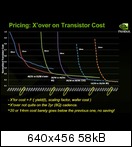Latest MSRPs of 28nm products are indicating, that 28nm could be 4-times expensive as 40nm comparing costs per mm^2, if the margins are equal to 40nm products.
Could be this real or is 28nm just wafer-limited and the prices are only so high to secure supply and to shift the margin in direction of manufactures instead of retail.
What could be a good estimate how expensive 28nm could be?
Could be this real or is 28nm just wafer-limited and the prices are only so high to secure supply and to shift the margin in direction of manufactures instead of retail.
What could be a good estimate how expensive 28nm could be?

